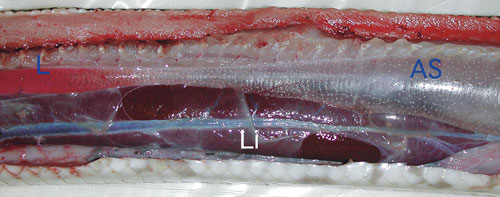Know your snake inside and out with this snake respiratory system anatomy overview.
Respiratory System
Snakes have a small opening just behind the tongue called the glottis, which opens into the trachea, or windpipe. Unlike what mammals have, the reptile glottis is always closed, forming a vertical slit, unless the snake takes a breath. A small piece of cartilage just inside the glottis vibrates when the snake forcefully expels air from its lungs. This produces a snake’s characteristic hiss. Snakes are able to extend their glottis out the side of their mouth while they eat, which allows for respiration while they consume large prey items.

Mader / Wyneken Collection
In the first quarter of the snake are the trachea (yellow arrow), thyroid (T), jugular vein (blue arrow), carotid artery (red arrow) and heart (H).
The trachea is a long, strawlike structure supported by cartilaginous rings. These rings are incomplete in that the snake looks more like a C than an O. A thin membrane completes the open part of the C. This configuration is also seen in lizards, but the function of the incomplete rings remains unknown. The trachea usually terminates just in front of the heart, and at this point it splits into the two primary bronchi, airways that direct air into either the left or right lung.
In most snakes the short left bronchus terminates in a vestigial, or rudimentary, left lung. The size and functional capacity of this lung varies depending on the species. It can be complete in some of the water snakes where it is used for hydrostatic purposes. The right bronchus terminates in the functional right lung.

Mader / Wyneken Collection
This close-up picture shows the lung’s respiratory portion (L), its air sac portion (AS) and the liver (Li).
Snakes breathe principally by contracting muscles between their ribs. Unlike mammals, they lack a diaphragm, the large smooth muscle responsible for inspiration and expiration between the chest and abdomen. Inspiration is an active process (muscles contract), whereas expiration is passive (muscles relax).
The portion of a snake’s lung nearest its head has a respiratory function; this is where oxygen exchange occurs. The lung portion nearest the tail, regardless of the lung’s size, is more of an air sac. The inside of these sac portions look more like the inside of a balloon than a lung. There is no exchange of respiratory gases.
Snake Cardiovascular System Anatomy>>
Snake Gastrointestinal Tract Anatomy>>



